Another Night at the Rusty Bridge - Astrophotography on HIVE
Nebulas and Galaxies
Vorgestern Nacht war ich ein weiteres Mal an der rostigen Brücke im Nirgendwo. Die Brücke ist seit einigen Jahren geschlossen, es fahren also keine Autos durch das Bild. Es gibt in der Nähe keine Städte und auch ansonsten wenig Lichtverschmutzung. Die Fahrt von Berlin dauert ungefähr eine Stunde.
Es war wolkenlos, es wehte nur sehr schwacher Wind und der Mond ging erst um 5:00 Uhr morgens auf. Perfekte Bedingungen um die Milchstraße zu fotografieren. Also fast, ich war nicht alleine an der Brücke. Unten am Fluss waren Angler, sie hatten einige Lampen aufgestellt. Mein ursprünglicher Plan, die Brücke und die Milchstraße von unten zu fotografieren, war damit zunichte gemacht. Wer nachts um 1:00 Uhr angelt, ist mindestens genauso besessen von dem was er tut, wie ich. Also hab ich die Angler nicht behelligt und das Beste aus der Situation gemacht.
The night before last, I was once again at the rusty bridge in the middle of nowhere. The bridge has been closed for several years, so there are no cars travelling through the picture. There are no towns nearby and otherwise little light pollution. The journey from Berlin takes about an hour.
It was cloudless, there was only a very light wind and the moon didn't rise until 5.00 am. Perfect conditions for photographing the Milky Way. Well, almost, I wasn't alone at the bridge. There were anglers down by the river and they had set up some lights. My original plan to photograph the bridge and the Milky Way from below was ruined. Anyone who fishes at 1 a.m. is at least as obsessed with what they do as I am. So I didn't bother the anglers and made the best of the situation.

Zuerst stellte ich eine Kamera direkt an der Brücke auf. Was diese Kamera fotografiert hat, zeige ich euch demnächst. Dann stellte ich die zweite Kamera mit dem 20 mm Voigtländer Color Skopar etwas weiter von der Brücke entfernt auf. Und nahm ein Bild des Vordergrundes der Szene auf. Die Blende hatte ich auf 3.5 eingestellt, den ISO auf 3200 und die Belichtungszeit betrug 120 Sekunden.
Firstly, I set up a camera right by the bridge. I'll show you what this camera photographed soon. Then I set up the second camera with the 20 mm Voigtländer Color Skopar a little further away from the bridge. And took a picture of the foreground of the scene. I had set the aperture to 3.5, the ISO to 3200 and the exposure time was 120 seconds.
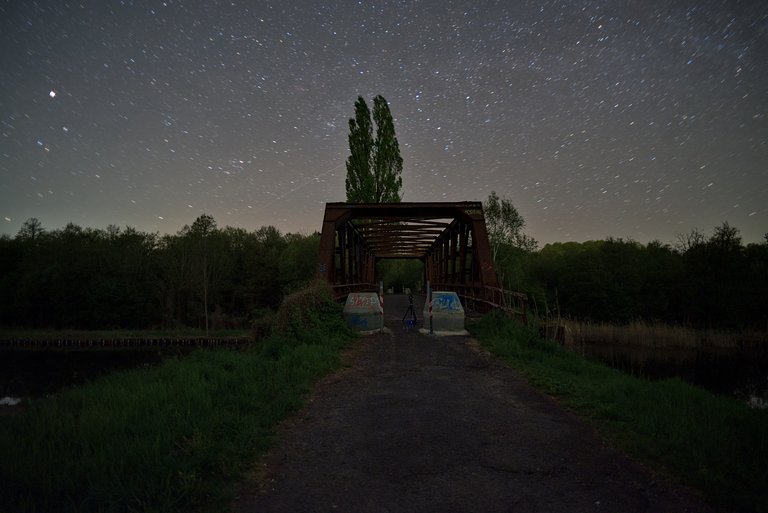
Danach richtete ich die Kamera weiter nach oben und nahm 8 Bilder des Sternenhimmels mit folgenden Einstellungen auf: ISO 6400, f3.5, 12 Sekunden. Die 8 Bilder stackte ich dann in Sequator. Das Bild sah dann so aus.
I then pointed the camera further up and took 8 pictures of the starry sky with the following settings: ISO 6400, f3.5, 12 seconds. I then stacked the 8 images in Sequator. The image then looked like this.
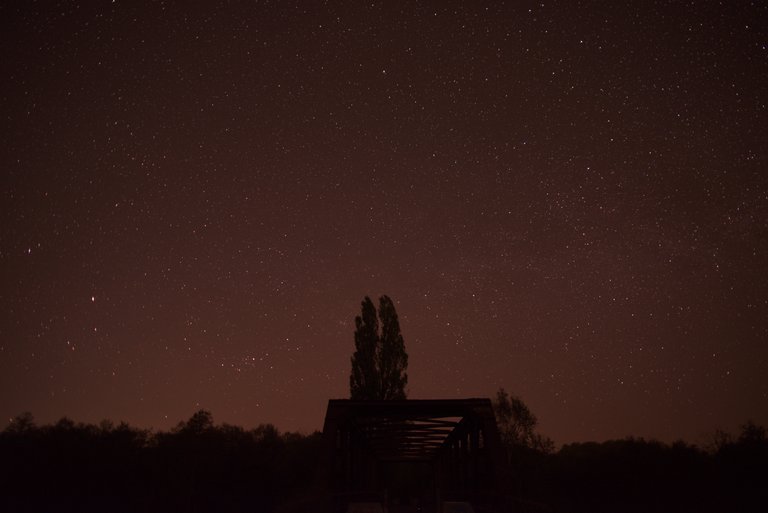
Im nächsten Schritt entfernte ich mit Starnet++ die Sterne aus dem Bild. Das sternenlose Bild öffnete ich dann in Darktable und passte Weißabgleich, Kontrast, Sättigung, Chrominanz und Luminanz an und entrauschte und schärfte das Bild.
In the next step, I used Starnet++ to remove the stars from the image. I then opened the starless image in Darktable and adjusted the white balance, contrast, saturation, chrominance and luminance and denoised and sharpened the image.

Ich benutzte meine auf volles Lichtspektrum umgebaute Nikon Z5. Vor dem Sensor hatte ich ein Astrofilter von Kolari Vision befestigt. In diesem Zustand nimmt die Kamera auch schwaches, größtenteils unsichtbares Licht von weit entfernten Nebeln und Galaxien auf. Die Strahlung im H𝛼 Bereich ist Rot bis Magenta, die Strahlung im OIII Bereich ist Blau und im SII Bereich ist Gelb bis Grün.
Das gestackte Bild der Sterne bearbeitete ich danach ebenfalls in Darktable. In GIMP habe ich dann die drei Bilder (Vordergrund, Sterne, sternenloses Bild) als Ebenen geöffnet und miteinander vereint. Das Freistellen des Vordergrundes war wegen das großen Baumes hinter der Brücke nicht ganz so einfach.
I used my Nikon Z5, which had been converted to full light spectrum. I had attached an astro filter from Kolari Vision in front of the sensor. In this state, the camera also picks up faint, mostly invisible light from distant nebulae and galaxies. The radiation in the H𝛼 range is red to magenta, the radiation in the OIII range is blue and in the SII range is yellow to green.
I then also processed the stacked image of the stars in Darktable. In GIMP, I then opened the three images (foreground, stars, starless image) as layers and merged them together. Cropping the foreground was not so easy because of the large tree behind the bridge.
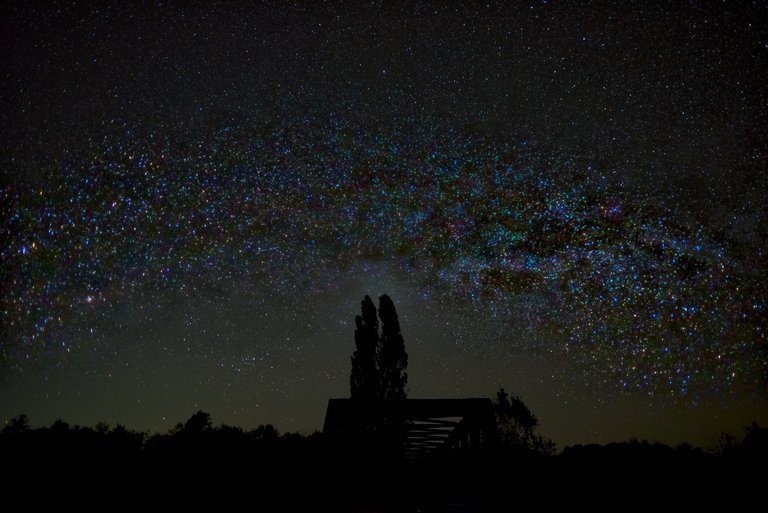
Im letzten Schritt habe ich das Bild quadratisch geschnitten. Das Ergebnis seht ihr ganz oben. Auch wenn das alles nicht wie geplant abgelaufen ist, bin ich mit dem Ergebnis sehr zufrieden. Ich hatte nicht damit gerechnet, in nur 50 km Entfernung von Berlin in einer Gegend mit Lichtverschmutzung der Stärke Bortle 3 bis 4 so viel Licht der Nebel und Galaxien einfangen zu können. Mit einem Schmalband-Passfilter ginge da sicher noch etwas mehr. Solche Filter sind allerdings sehr teuer und vollbringen auch keine Wunder. In diesem Licht allzeit gutes Licht.
In the last step, I cut the picture into a square. You can see the result at the top. Even though it didn't go as planned, I'm very happy with the result. I hadn't expected to be able to capture so much light from the nebulae and galaxies at a distance of just 50 kilometres from Berlin in an area with light pollution of Bortle 3 to 4. With a narrow-band pass filter, it would certainly be possible to achieve a little more. However, such filters are very expensive and do not work miracles. In this light, good light at all times.

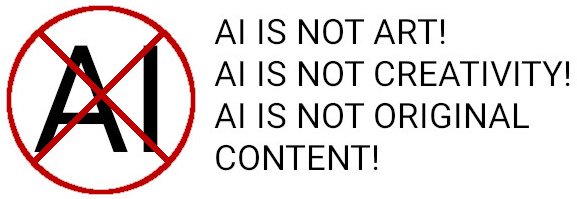

WHAT IS LIGHT PAINTING?

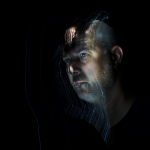
LICHTKUNSTFOTO
If you like my art visit www.lichtkunstfoto.de for more Light Art Photography and informations about Light Painting. Join me on Flickr Twitter



For more great Light Art Photography, Light Painting and inspiration check these light painters: @marlasinger666 @fadetoblack @fastchrisuk @dawnoner @oddballgraphics @martbarras @stepko @rod.evans.visual @yo-hoho @maxpateau @gunnarheilmann @neilru75 @maximepateau @ryuslightworks @lightstabeu @candelart @lacelight

WE ARE LIGHT PAINTERS
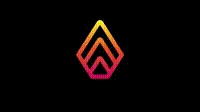
To help and support the LightPainters community here on Hive I would appreciate your delegation of HivePower. Any amount is appreciated. It does not require much to get started, we are happy for any gesture. @lightpainters
How to delegate?
Delegate 50HivePower, [50HP]
Delegate 250HivePower, [250HP]
Delegate 500HivePower, [500HP]
Delegate 1000HivePower, [1000HP]
All the Hive Power will help to upvote the artist's contribution as part of the LightPainters community.
You received an upvote ecency
Tolle Aktion und harte Arbeit zeigst du hier. Besonders interessant finde ich die verschiedenen Farben der Sterne.
Das nächste Mal nimmst du bestimmt einen Grill und eine Kiste Bier mit. Dann gibt es zusammen mit den Anglern ein Nachtmahl.
Bier und Grill? Dann kann ich auch das ganze schwere Fotozeug Zuhause lassen. 🤣
Moin, coole Sache. Die Sterne sind abgefahren. Gefällt mir. 😊
Das freut mich. 😊
Das nächste Mal kannste gerne wieder mitkommen.
Wowwwww, how amazing Shots
!DIY
Thanks
Starkes Compositing! Wirkt besonders auch durch die bunte Sternenpracht. Mit eienr weiteren Augnahme und nur etwas Mehrarbeit wären auch die Poller, Stangen und Kamerasetup verschwunden und die Stimmung wäre ev. noch verzauberter.(JM2C)
Danke. Mein erster Impuls war auch, die Kamera und die Absperrungen aus dem Bild zu entfernen. Ich habe mich dann dagegen entschieden. Vielleicht kommen dann weniger Leute auf die Idee, dass das Bild von der KI generiert wurde. Eigentlich ziemlich bekloppt, dass ich mir über so etwas Gedanken mache. Die Spuren der Flugzeuge und Satelliten habe ich dann aber doch aus dem Bild entfernt weil die sehr störend waren.
"Vielleicht kommen dann weniger Leute auf die Idee, dass das Bild von der KI generiert wurde" Interessanter Ansatz. Erinnert mich daran, dass in echten Perserteppichen absichtlich Fehler eingewebt werden, da nur Allah perfekt sein könne.
Starkes Compositing! Wirkt besonders auch durch die bunte Sternenpracht. Mit eienr weiteren Aufnahme und nur etwas Mehrarbeit wären auch die Poller, Stangen und Kamerasetup verschwunden und die Stimmung wäre ev noch verzauberter.